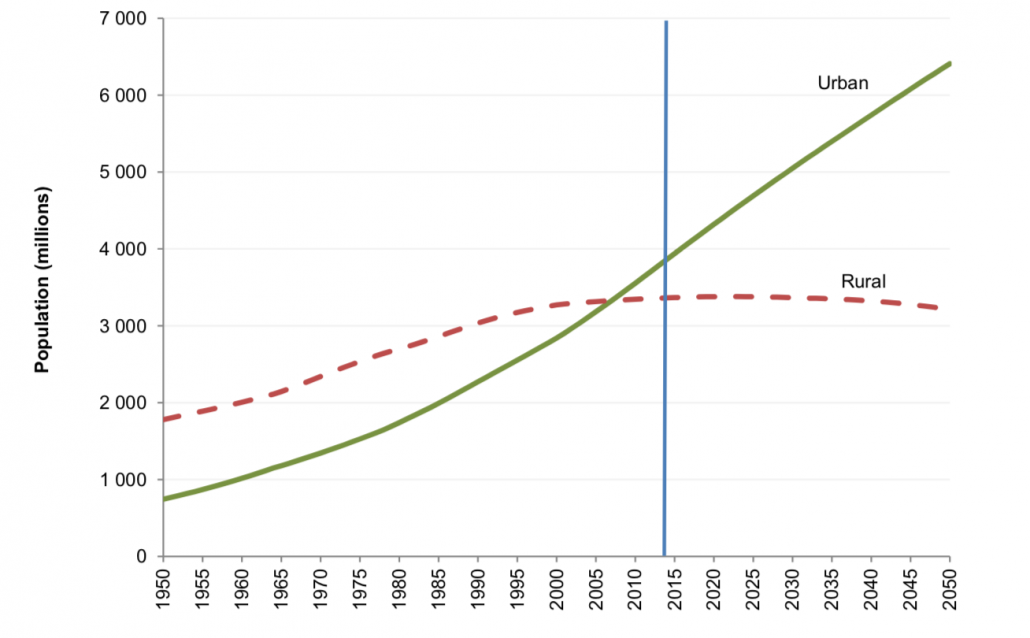An increasingly urbanised world
The world is becoming increasingly urbanised, as more people now live in towns and cities compared to 50 years ago. This increase in urbanisation is due to migration, the movement of people from rural areas to find jobs and better opportunities in the cities. By 2030, this number is expected to rise further, from 3.8 billion to 5.1 billion. It is expected that developing and emerging countries will see the biggest urbanisation, with 2.9 billion in 2014 to a staggering 4.1 billion by 2030. Developed countries are expected to experience slower growth, with projections indicating a rise from 1 billion to 1.05 billion by 2030.
Urbanisation in developed countries
Most developed countries experienced urbanisation during the Industrial Revolution, which took place in the 18th and 19th centuries. The development of factories encouraged the movement of rural workers to the towns and cities, but this urbanisation developed slowly over a longer period of time. There continues to be a steady growth of urbanisation in developed countries. With a low rate of natural increase and around 81% of people already living in urban areas in 2014, developed countries won’t see urbanisation at the same rate as developing and emerging countries in the future.
Urbanisation in developing and emerging countries
While urbanisation in developed countries is slow and steady, urbanisation in developing and emerging countries is more rapid, with most taking place in the last 50 years. Africa is expected to see the most significant rate of urban growth between 2020 and 2050, closely followed by Asia. High rates of natural increase and rural-urban migration are significant factors contributing to rapid urbanisation.
(Include graph showing a comparison of countries’ urban growth)
Mega Cities
While major cities have a population of 200,000 or more, to be classified as a megacity, the population must exceed 10 million. An example of a megacity is New York (USA), with 21 million people, and Mumbai (India), with 18 million people. Some of the first megacities were established in developed countries, including London, Paris and New York. These days, the majority of megacities are found in developing and emerging countries, particularly in Africa and Asia, which are often characterised by poverty and a high concentration of young adults seeking employment, such as Delhi in India and Lagos in Nigeria. There are now only eight megacities located in developed countries.
Primate Cities
Primate cities are important cities that lead in economics, financial and political systems. People move to these cities because of the opportunities available, and they are often the capital cities of the country. The population is usually double that of the next largest city and usually have the best infrastructure and transport links in the country. Industrial development and rural-urban migration contribute towards the growth of primate cities. However, due to their large populations, primate cities face numerous challenges, including traffic congestion, crime, housing shortages, and unemployment.
London is an example of a primate city, with a large population of over 9.5 million people, and it is home to the UK’s government and financial institutions. London is also considered the business capital of Europe.
World Cities
A primate city is the largest city in a country, whereas a world city is a global economic and cultural hub. These are often megacities with a large influence on global activities. London is also regarded as a global city due to its significant influence on international economic activity. Areas where London influences the global economy include:
- Investment: An important financial centre (along with New York), half of the world’s money comes through London each year, several trillion US dollars.
- Airline traffic: Heathrow, combined with Gatwick, Luton and Stansted, accounts for 120 million passengers a year, making it the largest travel hub in the world.
- Decision-making: 80% of transnational corporations (TNCs) have their headquarters in major world cities, including the UK, the USA, Japan, and EU countries. This is where they decide what to produce, sell and where they want to invest.
- Political decision: The UK has considerable influence in global decisions, and government decisions made in the UK can have global implications, whether it be on trade or conflict resolution.
Summary
Flashcards
Coming soon
Quiz
Coming soon



